Powderpost Beetle
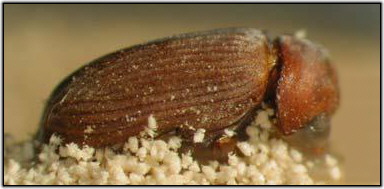 You may think that the powderpost beetle that is attacking your wood products are the adults, however, most damage done to furniture is from the mature larvae. This is because the adults don’t live very long—usually only long enough to lay eggs. Once the eggs hatch and the larvae are out, they begin to bore into and feed on the wood surrounding them. It can take up to five years before the larvae will mature into an adult. This means that they may be feeding on your furniture for up to five years! There have been reports of powderpost beetles emerging from furniture 35 years after it was infested!
You may think that the powderpost beetle that is attacking your wood products are the adults, however, most damage done to furniture is from the mature larvae. This is because the adults don’t live very long—usually only long enough to lay eggs. Once the eggs hatch and the larvae are out, they begin to bore into and feed on the wood surrounding them. It can take up to five years before the larvae will mature into an adult. This means that they may be feeding on your furniture for up to five years! There have been reports of powderpost beetles emerging from furniture 35 years after it was infested!
Powderpost beetles go through a complete metamorphosis, just like a fly or a flea. There is an egg, larvae, pupae and adult. Once the larvae have turned into adults, they will emerge from the wood. This will most likely happen during any of the months between April and July. You may notice tiny holes in your furniture from this process – these are called “exit” holes.
Once the adult female powderpost beetle emerges, it will mate with an adult male. She will then lay her eggs either on or beneath a piece of unfinished wood. Sometimes they will crawl into a crack or a joint in the wood to lay their eggs. While adults do not live long, they can live for several days or weeks. They are nocturnal in nature, making it difficult to find them during the day.
Anobiid Powederpost Beetle
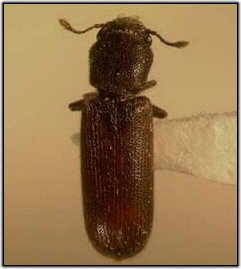 Anobiid powderpost beetles belong to the Anobiidae beetle family. They are close relatives to the Bostrichidae and Lyctidae beetle families. They are sometimes called “false powderpost beetles”. Anobiid powderpost beetles usually only attack sapwood, but they have been found in heartwood on rare occasions. They are most commonly found in the Pacific Northwest and are the most abundant on the coastal areas. The reason for this is that they do best when moisture is present. Unlike Lyctid and Bostrichidae powderpost beetles, the “frass” or powder of Anobiids are formed into tiny gritty fecal pellets.
Anobiid powderpost beetles belong to the Anobiidae beetle family. They are close relatives to the Bostrichidae and Lyctidae beetle families. They are sometimes called “false powderpost beetles”. Anobiid powderpost beetles usually only attack sapwood, but they have been found in heartwood on rare occasions. They are most commonly found in the Pacific Northwest and are the most abundant on the coastal areas. The reason for this is that they do best when moisture is present. Unlike Lyctid and Bostrichidae powderpost beetles, the “frass” or powder of Anobiids are formed into tiny gritty fecal pellets.
Anobiid powderpost beetles can be found in both soft wood and hard wood, but they thrive in woods with a moisture level higher than 14 percent. This makes wood in poorly ventilated places the most susceptible. However, you won’t be able to see the beetles because they destroy your wood from within. Therefore, in most cases, the only sign that there is an infestation is by discovering the “exit” holes from the adult beetles.
Anobiid powderpost beetles are the most common of all powderpost beetles. These wood infesting beetles have bodies that consist of a head that appears to be “hoodlike”. Their bodies are cylindrical, or elongated, and they are generally a reddish-brown/black in colour. They have protective wings that feature distinct pit-like rows, giving them a rigid, or hardened, appearance.
Anobiid powderpost beetles are usually only one-sixteenth to three-eighths of an inch long. However, it isn’t uncommon to find larger varieties in buildings, with some being up to one-quarter of an inch long.
While the adult Anobiid powderpost beetles are reddish-brown to black in colour, the mature worm like larvae are white and appear to be c-shaped. However, they do have the enlarged thorax and can also be three-sixteenths to a half inch long like the adults. Anobiid powderpost beetles are true insects and have six legs.
Lyctid Powderpost Beetles
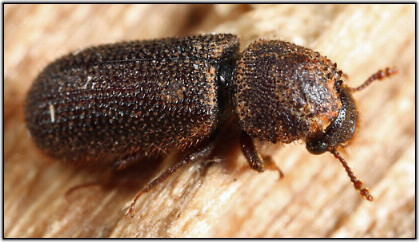 Lyctid powderpost beetles are generally found in wood such as myrtle, ash, hickory, oak, bamboo and mahogany. This is because these types of wood are large-pored. These insects are commonly found in the Pacific Northwest. Lyctid powderpost beetles are also found commonly in furniture, paneling and trim in the gulfcoast states.
Lyctid powderpost beetles are generally found in wood such as myrtle, ash, hickory, oak, bamboo and mahogany. This is because these types of wood are large-pored. These insects are commonly found in the Pacific Northwest. Lyctid powderpost beetles are also found commonly in furniture, paneling and trim in the gulfcoast states.
Custom home builders should beware that the expensive ash paneling and trim that they are installing in their beautiful new home could be infested with powderpost beetles! The “frass” or powder from Lyctid powderpost beetles is flour like. The exit holes are small pencil lead size holes, usually all the same size.
Lyctid powderpost beetles will usually only attack hard woods, although they have been reported in some soft woods as well.
Bostrichidae Powderpost Beetles
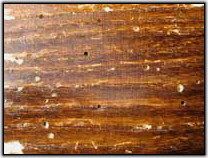
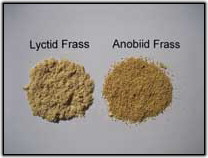 Bostrichidae powderpost beetles are not as common as Lyctidae and Anobiid powderpost beetles because they are usually only found in the tropics. They can be found in both soft woods and hard woods, but they prefer soft woods. Their “frass” or powder is very coarse, about the size of coffee grounds. They are sometimes referred to as “deathwatch beetles”.
Bostrichidae powderpost beetles are not as common as Lyctidae and Anobiid powderpost beetles because they are usually only found in the tropics. They can be found in both soft woods and hard woods, but they prefer soft woods. Their “frass” or powder is very coarse, about the size of coffee grounds. They are sometimes referred to as “deathwatch beetles”.
Once you’ve determined that there is an infestation, you need to determine if it is an active one. The signs that you have an active infestation include finding a light fresh-cut wood powder near the exit holes. You can easily determine if this is an active infestation by sealing the holes and cleaning up the dust surrounding them. Then, re-check the wood periodically to see if there are new holes.

